Discovering Uayma
Now and then, for obvious reasons, the Working Gringos pack a cooler, our two faithful dogs and our cameras into our camioneta to go in search of something beyond our computer monitors. This past weekend, we drove east and took the exit off the 180 Autopista to Valladolid with the intention of exploring the second largest city in Yucatan State. But when we stopped at the intersection of the 180 Libre, we saw one of those ubiquitous blue road signs with the international “historic town” symbol. On it was printed Uayma 13, and it pointed to the right.
We thought we had heard of Uayma (pronounced WHY-mah) somewhere before. Perhaps we had read about it in the local paper, Diario de Yucatán, or maybe someone had mentioned it to us over dinner. We couldn’t remember the context, but we thought Uayma might be famous for its Iglesia (church). So without much discussion, we shrugged, hit the turn signal and changed direction. Another typical road trip.
During the brief eight-minute drive, we pretended to decode the pueblo’s name. We know that uay is Mayan for a number of things, all bad. It’s the common expression for surprise, as in Uay! Alacrán! (Yikes! A scorpion!) It often means “haunted” when used in a place name. It can also mean “were”, as in werewolf, when applied to an animal. The dreaded Yucatan Uaychivo, a weregoat that terrorizes several local communities from time to time, is the most famous case in point. The word ma is less ambiguous; it’s the Mayan word for “no”. By the time we turned the corner into Uayma, we had decided that its name meant “No Fear.”
As we drove into town, the first thing we saw was the burned and battered ruin of a colonial train station. It was retreating into the encroaching selva, from which the long, straight iron tracks emerged only to disappear again. Something unpleasant had indeed happened here once, but as we drove on, there was little time to ponder it. The next building in sight was Uayma’s Palacio Municipal, or County Seat as we say back in Gringolandia, painted bright blue and looking like a birthday cake decoration.
We parked in the shade of a flamboyan tree near the pueblo’s central plaza. The weather this day could not have been more agreeable. The temperature hovered in the mid seventies, while a cool breeze carried the scent of fresh cut grass and rich forest soil. The sky was deep blue and heavy with stately white clouds that seemed motionless yet were continually changing shape. Birdsong and children’s laughter greeted us as we stepped onto the streets of Yucatan’s version of Mayberry R.F.D.
Uayma has benefited from the attentions of the Yucatan government and a healthy economy. The nearly 2,300 residents enjoy clean, paved streets, fresh paint and well-groomed gardens in their public park. We were told that a great many of Uayma’s workforce are bused to the Mayan Riviera, to work the hotel, restaurant and construction jobs that tourism brings. Many others work in one of the two maquiladoras (factories) located just outside town, stitching together jeans and tshirts. Still others continue to cultivate the fields as they have for generations, to harvest corn, beans and fruit. By all accounts, there are no pobres (poor people) in Uayma, and the folks we encountered displayed an air of tranquility and confidence that would be expected from a Norman Rockwell painting.
The centerpiece of this peaceful town is the recently completed restoration of the cathedral, one of the most unique in Yucatan. We talked to the caretaker, Ruben, about the history of the church. He told us that Uayma had been an important religious center for the Maya and when the Spaniards arrived, they used stones of nearby archaeological sites – including Chichen Itza – to construct a Templo Mariano, or temple for the worship of La Virgen. The Franciscan order converted this into a convent and named Santo Domingo (Saint Dominic) the patrón, or patron saint, of Uayma. As years went by, the secular clergy of Uayma converted the convent into the town’s church.
During the Yucatan Caste War of the middle 19th century, the Cruzob Maya from the southern part of the peninsula tried to destroy any evidence of colonial rule in Yucatan, including Uayma’s Franciscan ex-convent. Other artifacts of the Caste War can be seen around the town of Uayma, where all colonial structures – including the train station – have been left to crumble into dust.
Several years ago, many special colonial structures around Yucatan were identified and restored through the efforts of Elba Villareal de Garcia Ponce and Fernando Garces Fierros, through both a private program called Adopte una Obra de Arte (Adopt a Work of Art) and the government’s Institute of Anthropology and History (INAH). One of the lucky recipients of this effort was Uayma’s ex-convent. One look at the rosette facade will tell you why. There’s simply nothing else like it in Yucatan.
Although the beauty of the church speaks for itself, there is an unusual juxtaposition of symbolism that we were unable to decipher. Many of the churches and cathedrals of Yucatan were made from stones taken from Mayan sites, but this church is rather unique in that several stones from a Mayan façade are reassembled and prominently mounted above the entrance. Above these is a representation of the double-headed eagle, which would easily be explained as an element of the Hapsburg coat of arms - the power behind the Spanish throne at the time - except this symbol does not appear anywhere else in Yucatan that we have seen. Was this symbol a private embellishment or did it have a special meaning to the local Maya as well? And what about all those rosettes? Are these an adaptation of a Mayan design, or are they derived from the Golden Chains of Navarre, an important element in the Spanish coat of arms? And why was the founder of the Dominican Order, whose tiny statue is mounted at the top of the church’s façade, named the Patrón of a convent built by the Franciscans? So many mysteries, so little time.
After a tour of the town center and the church, we spent some time letting the dogs play with some of the children in the park, then letting the children play with our cameras. Much of Uayma’s population is hidden alongside roads that snake into the jungle, so we ventured back through some of these neighborhoods, as well. We met some lovely Uaymanians (Uaymatecos? Uaymanos?) who seemed to bear out our initial impression of a friendly and peaceful town. We had visions of building a country home in an abandoned building on a back street. We were told that the government of Yucatan is including this town as one of the attractions on a tour route that includes the nearby colonial city of Valladolid and the Mayan ruins at Ek Balam. At the very least we certainly plan to come back and enjoy the activities leading up to their fiesta on August 8th, the feast day of Santo Domingo.
While we may never solve the mysteries of Uayma’s church, one important mystery was explained before we left. According to Ruben, the town’s name is a Maya contraction that means agua del huayo, or water from fruit, or to put it more simply: juice. Okay, maybe we're not experts in Mayan translation, but we're not convinced. We didn't see any NO FEAR surf shops in Uayma, but we didn't see any juice vendors either. So the origin of Uayma's name remains a mystery to us... like a lot of things around here.




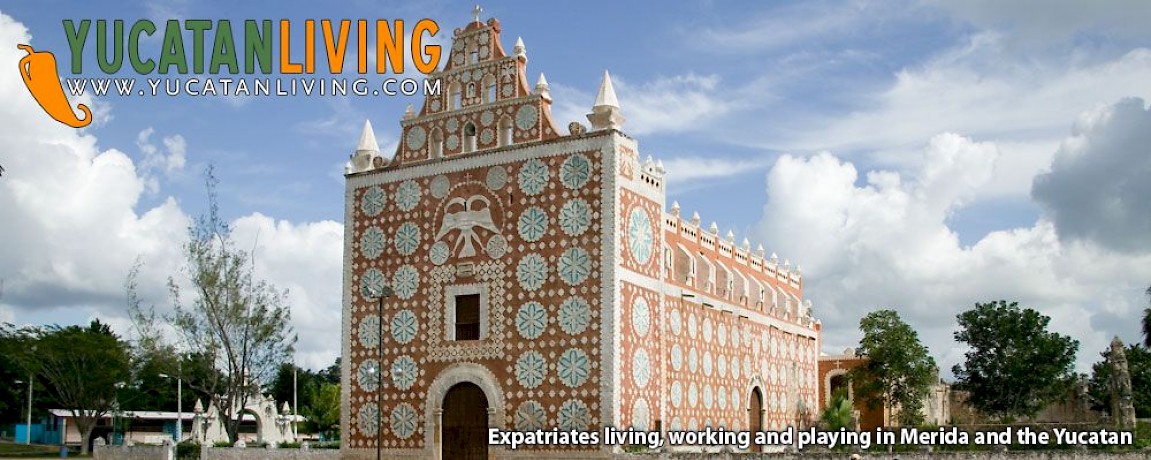


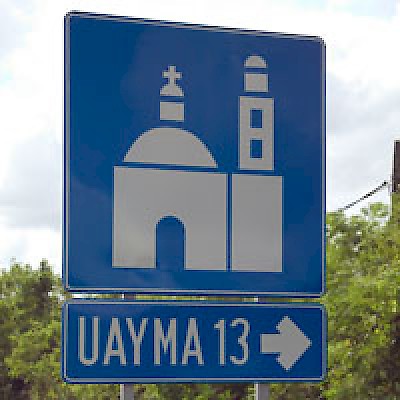
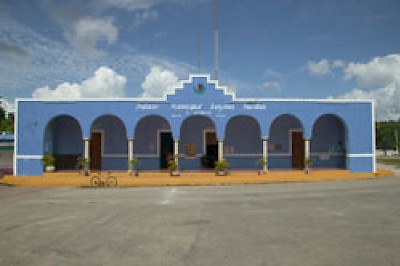
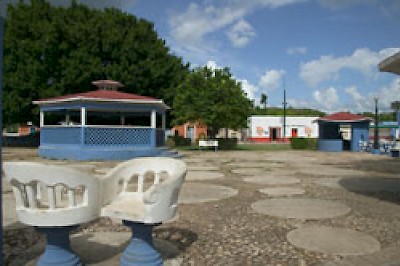
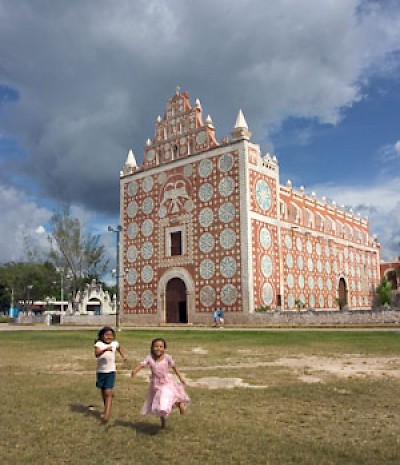
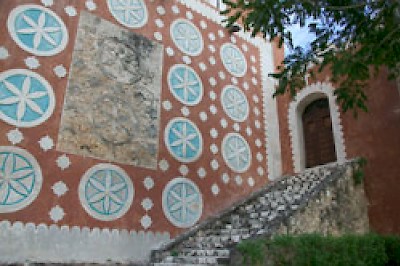
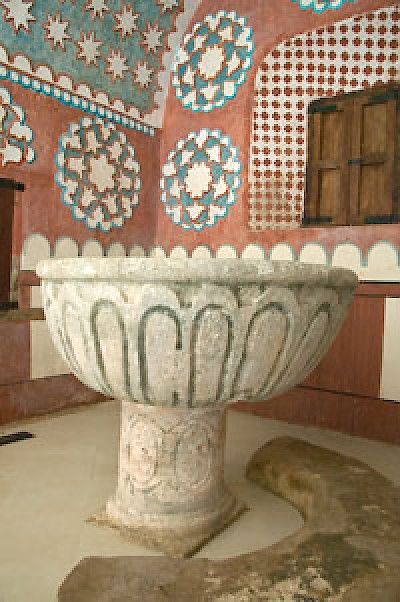
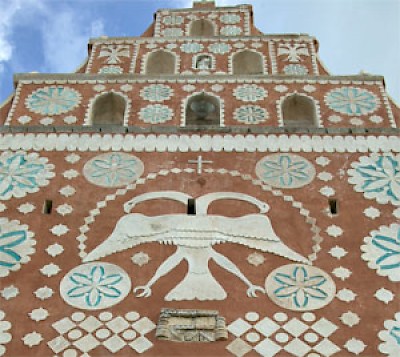
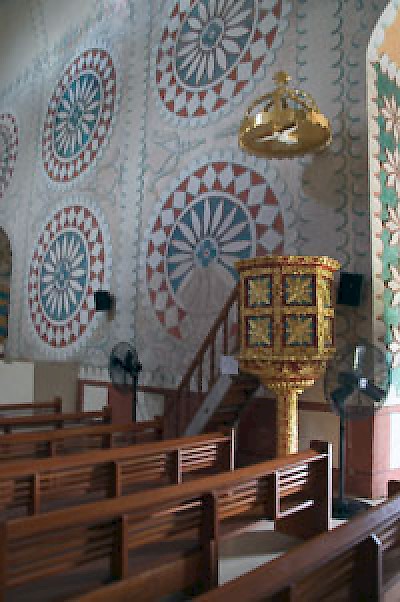

Comments
CasiYucateco 16 years ago
Very interesting! This feels like the beginnings of a 'Da Vinci Code' adventure... Wouldn't it be cool to find out the origin of the symbol in Merida? Could it be something connected to the brotherhood of monks at that church, versus others? ...
Reply
Reinhold Kriegler 16 years ago
Hola!
I have inserted two pictures of your church into the link
http://www.ta-dip.de/172,0,from-naniflower-to-hexafolia,index,0.html
Please help me to find more churches which use this sign!
Best wishes!
R. Kriegler
¡Hola!
Yo he insertado dos cuadros de su iglesia en el eslabón
http://www.ta-dip.de/172,0,from-naniflower-to-hexafolia,index,0.html
¡Por favor ayude que yo encuentre más iglesias que usan esta señal!
¡Los deseos más buenos!
R. Kriegler
Reply
gianfranco 16 years ago
very interesting, thanks!
Reply
Orgullosamente Yucaterco 17 years ago
Thank you for putting up all of this information on Uayma! In 2004 I lived in Valladolid for a few months, and often visited Uayma. When I was there the church was still being restored, and was still in a general state of disaray and covered in scaffolding. I cant believe how it turned out! One thing I remember about Uayma is how not very many people spoke spanish. Almost everyone there speaks fluent mayan, and so we had to have a translator go around with us. Someday, I hope that I can make it back to visit Uayma!
Reply
Yucatan Living - Valladolid, Sultaness of the East 17 years ago
[...] in the Yucatan. We haven’t even mentioned that Valladolid is just 15 short kilometers from Uayma, one of our favorite Yucatan destinations. And we haven’t even touched on the cenotes within [...]
Reply
The Yucatan Symphony Orchestra 18 years ago
[...] As the symphony orchestra has grown and coalesced, it has become the flagship project of the ICY, as it has put Merida on the cultural map in Mexico and Latin America. Who knows exactly what has been the impetus, but according to Elizabeth Arnott and others, in the last few years we have seen not only the growth of the symphony, but we have been witnesses to a cultural renaissance in Merida. The symphony has been host to multiple visiting soloists and conductors from around the world. It has performed educational concerts in universities, as well as popular concerts in Izamal, Valladolid and at the reopening of the refurbished church at Uayma. It has even performed Swan Lake in support of a performance of the Cuban Ballet. [...]
Reply
JUAN ANTONIO ROSALES GONZALEZ 18 years ago
Un mensaje para Fernando con motivo de la defunción de su madre,el 28 de marzo de 2007. Admiro sus obras de recuperación del legado de nuestros ancestros. Espero que me conteste, hay un asunto sobre Omar Max.
Reply
Genny M. 18 years ago
Hello Workin Gringos:
Uayma according to the Dictionario Maya Cordemex is a (toponimico) for Uayum-ha that means: agua junto al arbol... Regarding the yucatecan flag, the stars represent the 5 districts of the independance nation of Yucatan, my Antropologist husband says is Valladolid, Merida, Campeche he doesn't recall the other two might be either Bacalar or Chetumal, or Ticul, the hole Peninsula was one independant nation for few years before divide by Mexico and reunited to the republic. My husband also said that during this period of independance the yucatecan government had requested help and assistance to the government of the United States during President Poks'administration so we (the yucatecos) almost became a state of the United States, but the request was the denied, also France and Spain deneid Yucatecans request. This was during the period of the mayan uprising "La Guerra de las Castas".
From Genny La Peregrina
Reply
Working Gringos 18 years ago
Que raro, Dave, we're seeing those same bunnies too...
Reply
Dave 18 years ago
Loved your story. When I look at the double headed eagle, I see a face. The dimonds arching over the the top as he top of a head, the dimonds below the "wings" are eyes and the stone below the eagle is a mouth. Maybe I'm seeing bunnies in the clouds or maybe the Mayans got the last word. OOOOOH.
Reply
CasiYucateco 18 years ago
To my understanding, the 5 stars in the Yucatan flag date back before the existence of all the states mentioned by Carlos.
100-200 years ago, it was all "Yucatan". The stars supposedly represent the 5 main 'departamentos' of Yucatan, represented by the main city - the "county seat" of each of the geographic/governmental districts: Merida (1st), Campeche (2nd), Valladolid (3rd), Izamal (4th) and Tekax (5th departamento of Yucatan).
The flag originated in 1841 - along with the Republic of Yucatan - in opposition to Santa Anna's centralization of power in Mexico City.
"Back in the day" supposedly each of the five departamentos had their own flags as well. As far as can be determined (by me), only the Tekax flag design survives. Here is a link to the Flags of the World site showing the Tekax flag:
http://www.fotw.net/flags/mx-tek.html
I've hunted around for any other information about the other 4 missing flags, but to no avail. There's a nice elderly fellow who sells various information about the (old) history of the area at "Noche Mexicana" on the south end of Paseo Montejo Saturdays and a little parque Sunday mornings. He hasn't found the other four either.
Reply
« Back (10 to 21 comments)Next »